The Nucleoskeleton
- PMID: 28148597
- PMCID: PMC5287075
- DOI: 10.1101/cshperspect.a023556
The Nucleoskeleton
Abstract
SUMMARYThe nucleoskeleton is an important structural feature of the metazoan nucleus and is involved in the regulation of genome expression and maintenance. The nuclear lamins are intermediate filament proteins that form a peripheral nucleoskeleton in concert with other lamin-associated proteins. Several other proteins normally found in the cytoskeleton have also been identified in the nucleus, but, as will be discussed here, their roles in forming a nucleoskeleton have not been elucidated. Nevertheless, mutations in lamins and lamin-associated proteins cause a spectrum of diseases, making them interesting targets for future research.
Copyright © 2017 Cold Spring Harbor Laboratory Press; all rights reserved.
Figures



References
-
- Aebi U, Cohn J, Buhle L, Gerace L. 1986. The nuclear lamina is a meshwork of intermediate-type filaments. Nature 323: 560–564. - PubMed
-
- Amendola M, van Steensel B. 2014. Mechanisms and dynamics of nuclear lamina–genome interactions. Curr Opin Cell Biol 28: 61–68. - PubMed
-
- Arlucea J, Andrade R, Alonso R, Arechaga J. 1998. The nuclear basket of the nuclear pore complex is part of a higher-order filamentous network that is related to chromatin. J Struct Biol 124: 51–58. - PubMed
Publication types
MeSH terms
Substances
LinkOut - more resources
Full Text Sources
Other Literature Sources
